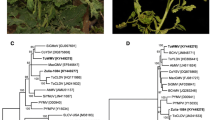Abstract
The complete genome sequences of two monopartite begomovirus isolates (genus Begomovirus, family Geminiviridae) that occurred either alone or in mixed infection in sweet potato (Ipomoea batatas) plants collected in Waterpoort, South Africa, are presented. One of the isolates corresponds to sweet potato mosaic-associated virus (SPMaV; SPMaV-[ZA:WP:2011]), with which it shared 98.5 % nucleotide identity, whereas the second isolate corresponds to a new variant of sweet potato leaf curl Sao Paulo virus (SPLCSPV; SPLCSPV-[ZA:WP:2011]), with which it shared 91.4 % nucleotide identity. The phylogenetic and recombination relationships of these isolates to other monopartite Ipomoea-infecting begomoviruses were also investigated. SPLCSPV-[ZA:WP:2011] was found to be a natural recombinant of swepoviruses consisting of two distinct parental genomic sequences from SPLCSPV and sweet potato leaf curl Georgia virus (SPLCGV).


Similar content being viewed by others
References
Albuquerque LC, Inoue-Nagata AK, Pinheiro B, Ribeiro SG, Resende RO, Moriones E, Navas-Castillo J (2011) A novel monopartite begomovirus infecting sweet potato in Brazil. Arch Virol 156:1291–1294
Argüello-Astorga GR, Ruiz-Medrano R (2001) An iteron-related domain is associated to Motif 1 in the replication proteins of geminiviruses: identification of potential interacting amino acid-base pairs by a comparative approach. Arch Virol 146:1465–1485
Banks GK, Bedford ID, Beitia FJ, Rodriguez-Cerezo E, Markham PG (1999) A novel geminivirus of Ipomoea indica (Convolvulacae) from Southern Spain. Plant Dis 83:486
Briddon RW, Bull SE, Bedford ID (2006) Occurrence of Sweet potato leaf curl virus in Sicily. Plant Pathol 55:286
Clark CA, Hoy MW (2006) Effects of common viruses on yield and quality of Beauregard sweet potato in Louisiana. Plant Dis 90:83–88
Fuentes S, Salazar LF (2003) First report of Sweet potato leaf curl virus in Peru. Plant Dis 87:98
Domola MJ (2003) Survey and characterization of sweet potato viruses in South Africa. M. Sc thesis, University of Pretoria, South Africa
Fauquet CM, Stanley J (2003) Geminivirus classification and nomenclature: progress and problems. Ann Appl Biol 142:165–189
Fauquet CM, Briddon RW, Brown JK, Moriones E, Stanley J, Zerbini M, Zhou X (2008) Geminivirus strain demarcation and nomenclature. Arch Virol 153:783–821
Haible D, Kober S, Jeske H (2006) Rolling circle amplification revolutionizes diagnosis and genomics of geminiviruses. J Virol Methods 135:9–16
Harrison BD (1985) Advances in geminivirus research. Annu Rev Phytopathol 23:55–82
Lefeuvre P, Martin DP, Hoareau M, Naze F, Delatte H, Thierry M, Varsani A, Becker N, Reynaud B, Lett JM (2007) Begomovirus ‘melting pot’ in the south-west Indian Ocean islands: molecular diversity and evolution through recombination. J Gen Virol 88:458–3468
Ling K-S, Jackson DM, Harrison H, Simmons AM, Pesic-VanEsbroeck Z (2010) Field evaluation of yield effects on the U.S.A. heirloom sweet potato cultivars infected by Sweet potato leaf curl virus. Crop Prot 29:757–765
Lole KS, Bollinger RC, Paranjape RS, Gadkari D, Kulkarni SS, Novak NG, Ingersoll R, Sheppard HW, Ray SC (1999) Full-length human immunodeficiency virus type 1 genomes from subtype C-infected seroconverters in India, with evidence of intersubtype recombination. J Virol 73:152–160
Lotrakul P, Valverde RA, Clark CA, Sim J, De La Torre R (1998) Detection of a geminivirus infecting sweet potato in the United States. Plant Dis 85:1253–1257
Lotrakul P, Valverde RA, Clark CA, Fauquet CM (2003) Properties of a begomovirus isolated from sweet potato (Ipomoea batatas (L.) Lam.) infected with Sweet potato leaf curl virus. Rev Mex Fitopatol 21:128–136
Lozano G, Trenado HP, Valverde RA, Navas-Castillo J (2009) Novel begomovirus species of recombinant nature in sweet potato (Ipomoea batatas) and Ipomoea indica: taxonomic and phylogenetic implications. J Gen Virol 90:2550–2562
Luan YS, Zhang J, An LJ (2006) First report of Sweet potato leaf curl virus in China. Plant Dis 90:1111
Luan YS, Zhang J, Liu DM, Li WL (2007) Molecular characterization of Sweet potato leaf curl virus isolate from China (SPLCV-CN) and its phylogenetic relationship with other members of the Geminiviridae. Virus Genes 35:379–385
Martin DP, Lemey P, Lott M, Moulton V, Posada D, Lefeuvre P (2010) RDP3: a flexible and fast computer program for analyzing recombination. Comput Appl Biosci 26:2462–2463
Miano DW, LaBonte DR, Clark CA, Valverde RA, Hoy MW, Hurtt S, Li R (2006) First report of a begomovirus infecting sweet potato in Kenya. Plant Dis 90:832
NDA (2010) A profile of the South African sweet potato market value chain 2010. Department of Agriculture, Forestry and Fisheries, Republic of South Africa. http://www.daff.gov.za/docs/AMCP/SweetPotatoVCP2010-11.pdf
NDA (2011) Abstract of agricultural statistics 2011. Department of Agriculture, Forestry and Fisheries, Republic of South Africa. http://www.daff.gov.za/docs/statsinfo/Abstract_2011.pdf
Rännäli M, Czekaj V, Jones RAC, Fletcher JD, Davis RI, Mu L, Dwyer GI, Coutts BA, Valkonen JPT (2008) Molecular genetic characterization of Sweet potato virus G (SPVG) isolates from areas of the Pacific Ocean and southern Africa. Plant Dis 92:1313–1320
Rännäli M, Czekaj V, Jones RAC, Fletcher JD, Davis RI, Mu L, Valkonen JPT (2009) Molecular characterization of Sweet potato feathery mottle virus (SPFMV) isolates from Easter Island, French Polynesia, New Zealand, and southern Africa. Plant Dis 93:933–939
Paprotka T, Boiteux LS, Fonseca ME, Resende RO, Jeske H, Faria JC, Ribeiro SG (2010) Genomic diversity of sweet potato geminiviruses in a Brazilian germplasm bank. Virus Res 149:224–233
Prasanth G, Hegde V (2008) Occurrence of Sweet potato feathery mottle virus and Sweet potato leaf curl Georgia virus on sweet potato in India. Plant Dis 92:311
Wasswa P, Otto B, Maruthi MN, Mukasa SB, Monger W, Gibson RW (2011) First identification of a sweet potato begomovirus (swepovirus) in Uganda: characterization, detection and distribution. Plant Pathol. doi:10.1111/j.1365-3059.2011.02464.x
Author information
Authors and Affiliations
Corresponding author
Rights and permissions
About this article
Cite this article
Esterhuizen, L.L., van Heerden, S.W., Rey, M.E.C. et al. Genetic identification of two sweet-potato-infecting begomoviruses in South Africa. Arch Virol 157, 2241–2245 (2012). https://doi.org/10.1007/s00705-012-1398-4
Received:
Accepted:
Published:
Issue Date:
DOI: https://doi.org/10.1007/s00705-012-1398-4




